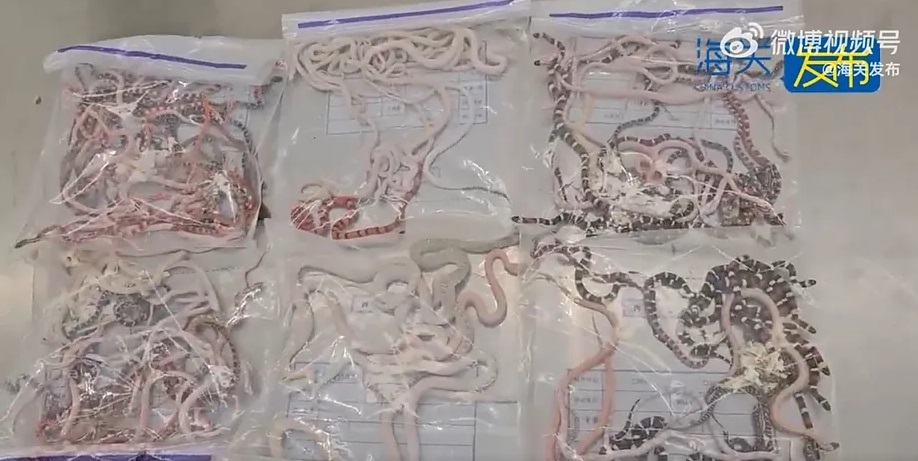The man was wearing an oversized black jacket and fairly loose dark pants. He also had a backpack, but it was his strange way of walking, stumbling nervously from side to side, that caught the attention of the authorities at the Hong Kong border control point. While crossing into the neighboring Chinese city of Shenzhen, customs agents stopped the traveler and asked him to accompany them to a room for inspection.
That passage from Hong Kong to Shenzhen is famous for being one of the most critical points worldwide in terms of species trafficking. The agents have seen it all. But what the man in the black jacket had on him exceeded all expectations: 104 live snakes hidden in the pockets of his pants.
The reptiles, of all sizes, shapes, and colors, were crammed into six drawstring canvas bags. Customs authorities posted a video this week on Weibo, the Chinese version of X, showing the officers opening the bags and examining the snakes: red, black, pink, yellow...
"Five species have been identified (milk snakes, corn snakes, Texas rat snakes, western hognose snakes, and gopher snakes) that are non-venomous. They are endemic to North America and are frequently found in the exotic pet trade in China, where they risk becoming an invasive species," reads the statement released by the authorities. "Upon inspecting the passenger, customs agents discovered that the pockets of his pants were filled with six bags sealed with adhesive tape," it continues.
The news quickly spread from China and has gone around the world in several languages. Less than a year ago, at the same Hong Kong to Shenzhen crossing, a woman was detained while trying to smuggle five small snakes hidden inside her bra.
In the Asian giant, these small snakes have long been in demand as exotic pets for many young people, although they are prohibited in homes by the Wild Animal Conservation Law, which was strengthened last year to include new species of commonly trafficked animals.
But the greater demand lies in their skin, meat, or venom for traditional Chinese medicine. In Zhejiang, a province in the southeast, there is Zisiqiao, a village famous for having over a hundred farms that breed snakes: they breed over three million snakes each year for food and medicine.
The village residents make a living by selling these snakes to Chinese pharmaceutical companies that turn the venom or skin into ointments that are also exported to neighboring countries like Japan and South Korea. Many buyers believe it can serve as a kind of elixir for eternal youth.
This year, Chinese media have reported on how authorities in countries like India or Bangladesh have seized snake venom destined for China for use in traditional medicine. In the Indian state of West Bengal, the police arrested a man with two kilograms of snake venom, which they claimed had a market value of 120 million rupees, which is equivalent to about one and a half million euros.
In 2023, China Customs launched a campaign to end smuggling and said they had intercepted 1,186 non-native species in a year, including 44,000 exotic pets. A month ago, a man was detained at the Macau border checkpoint for trying to enter mainland China with 20 endangered turtles.
China and Hong Kong, which is one of the world's main transit points for wildlife smuggling - with the most common being shark fins and rhinoceros horns - have tightened customs controls since the pandemic to monitor species trafficking, although conservationists are calling for stricter laws to prevent reptiles like snakes from becoming a sought-after delicacy or an elixir for traditional medicine.
